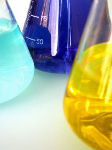
Purpose
To determine which chemicals are acids and which are bases.
Additional information
An acid, represented by the formula HA, is a chemical compound that, when dissolved in water, results in a solution whose hydrogen ion activity is greater than in pure water (a pH less than 7.0). It wasn't until the 17th century that an acid was properly defined. Amateur chemist Robert Boyle defined acids as having the properties of sour taste, corrosiveness to materials, and becoming less acidic when mixed with bases.
A base, at least one interpretation of a base, is a chemical that is opposite of acids. When a base is added to an acid, neutralization occurs. Where-as acids increase the hydronium ion concentration in water, bases decrease it (opposite effect of an acid). According to Boyle, bases have a slippery feeling and become less basic when mixed with acids.
Sponsored Links
Required materials
- Red cabbage leaves
- Water
- Bowl
- Colanders (food strainer)
- Vinegar
- Lemon juice (fresh squeezed or lemonade)
- Bicarbonate of soda (aka: baking soda)
- Laundry detergent
- Several glass jars of the same size (vials preferred)
- Eye-dropper (optional)
Estimated Experiment Time
About 45 minutes to an hour
Step-By-Step Procedure
- 1. Cut your cabbage leaves into small pieces.
- 2. Boil several cups of water. They'll need to be enough water to submerge your cut cabbage pieces later on.
- 3. Place your cut cabbage in a bowl. Pour the boiling water into the bowl. Let the cabbage pieces soak for at least thirty minutes (your water should become a dark-purplish color).
- 4. Separate the cooled "cabbage juice" from the leaves. You can either take the cabbage out with a holed-spoon or pour the bowl of cabbage juice into a strainer over another bowl, allowing the strainer to filter-out the cabbage pieces.
- 5. Line up your glass jars, about one or two inches apart. Pour some of each chemical (vinegar, lemon juice, bicarbonate of soda, and laundry detergent) into each jar.
- 6. Now it's time to test if your chemical is an acid or a base. Pour a dash of your cabbage juice into each jar/vial. To avoid pouring too much, you may want to use an eye-dropper. You may also need to swirl your mixture around a bit. What happens to each mixture of cabbage juice and chemical? If your mixture turned pink, your chemical is an acid. If your mixture turns blue or green, your chemical is a base.
Note
This is an interesting and safe experiment that can be conducted right in your own kitchen with commonly available household items. If you're having difficulty getting your "cabbage juice" to work as a proper indicator, it's possible you didn't let it soak long enough. It's recommended to let it soak a minimum of thirty minutes, but waiting an hour will be the most effective.
Observation
What other chemicals can you find around your house that would make good candidates for testing as acid or bases? Try using toothpaste, fruit, vegetables, and other common household items. You can even try using beverages. For example, is Gatorade a base or acid? How about Dr. Pepper? Can you guess which are acids and which are bases before mixing your cabbage juice?
Result
Chemicals are either acids or bases. When you left your cabbage soaking in the boiling water, the juice from the cabbage was extracted. The cabbage juice acts as an acid/base indicator. When the indicator is added to the various chemicals, the color changes to indicate which chemical is an acid and which is a base. The best part is you can keep your cabbage juice in a jar for later experimentation as an inexpensive acid/base indicator.
Sponsored Links
Take a moment to visit our table of Periodic Elements page where you can get an in-depth view of all the elements,
complete with the industry first side-by-side element comparisons!